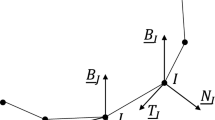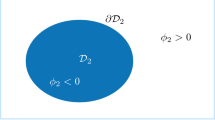Abstract
At present, the eXtended Finite Element Method (X-FEM) is a common generalization of the classical finite element method for solving problems of deformable solid mechanics in the presence of large cracks. The main advantage of this method is the possibility of using computational meshes that are not consistent with the crack geometry and the feasibility of accurately taking into account the singular asymptotics of the solution near the front of the crack. One of the key elements of this method is the way that the middle surface of the crack is represented in the algorithm. It is traditional to use an implicit surface representation based on the level set method. Such an approach is efficient and robust and allows the calculation in the case of propagating cracks. In the paper, we propose a version of the X-FEM approach which uses the closest point projection (CPP) method to represent the middle surface of the crack and provides, in our opinion, several advantages over the common X-FEM. The paper presents a short overview of the classical X-FEM technique. The proposed algorithm and its distinctions from the conventional one are described in detail and its advantages are formulated. We consider the problems of the numerical integration of functions defined on the surface described by the closest point projector method, the local recovery of the level set functions, and the computation of local frames at a point of the surface or its edge. The algorithmic details of the X-FEM enriched with a surface representation based on the projection of the closest point are described. In conclusion, we present some numerical results that demonstrate the algorithmic features of the method and performance capabilities of the proposed algorithm.










Similar content being viewed by others
REFERENCES
T. Belytschko and T. Black, “Elastic crack growth in finite elements with minimal remeshing,” Int. J. Numer. Methods Eng. 45, 601–620 (1999).
N. Moes, J. Dolbow, and T. Belytschko, “A finite element method for crack growth without remeshing,” Int. J. Numer. Methods Eng. 46, 131–150 (1999).
T. P. Fries and T. Belytschko, “The extended/generalized finite element method: an overview of the method and its applications,” Int. J. Numer. Methods Eng. 84, 253–304 (2012).
T. P. Fries, N. Moës, and A. Zilian, “The extended finite element method. Special issue,” Int. J. Numer. Methods Eng. 86, 403–666 (2011).
A. Gravouil, N. Moës, and T. Belytschko, “Non-planar 3D crack growth by the extended finite element and level sets. Part II: Level set update,” Int. J. Numer. Methods Eng. 53, 2569–2586 (2002).
N. Moës, A. Gravouil, and T. Belytschko, “Non-planar 3D crack growth by the extended fiite element and level sets. Part I: Mechanical model,” Int. J. Numer. Methods Eng. 53, 2549–2568 (2002).
S. J. Osher and R. P. Fedkiw, Level Set Methods and Dynamic Implicit Surfaces (Springer, New York, 2002).
M. Stolarska, D. Chopp, N. Moës, and T. Belytschko, “Modelling crack growth by level sets in the extended finite element method,” Int. J. Numer. Methods Eng. 51, 943–960 (2001).
C. B. Macdonald, J. Brandman, and S. J. Ruuth, “Solving eigenvalue problems on curved surfaces using the Closest Point Method,” J. Comput. Phys. 230, 7944–7956 (2011).
G. Ventura, E. Budyn, and T. Belytschko, “Vector level sets for description of propagating cracks in finite elements,” Int. J. Numer. Methods Eng. 58, 1571–1592 (2003).
M. Berger, A. Tagliasacchi, L. Seversky, P. Alliez, J. Levine, A. Sharf, and C. Silva, “State of the art in surface reconstruction from point clouds,” in Proceedings of the EUROGRAPHICS 2014, STAR - State of The Art Report, Ed. by S. Lefebvre and M. Spagnuolo (2014).
A. V. Ivanov and E. B. Savenkov, “Simulation and visualization of the dynamics of a surface with a movable boundary on a stationary unstructured mesh,” Nauch. Vizualiz. 9 (2), 64–81 (2017).
T. März and C. B. Macdonald, “Calculus on surfaces with general closest point functions,” SIAM J. Numer. Anal. 50, 3303–3328 (2012).
O. C. Zienkiewicz and R. L. Taylor, The Finite Element Method (Butterworth-Heinemann, Oxford, 2005).
A. F. Bower, Applied Mechanics of Solids (CRC, Boca Raton, FL, 2009).
Funding
This work was supported by the Russian Science Foundation, grant no. 15-11-00021.
Author information
Authors and Affiliations
Corresponding authors
Ethics declarations
The authors declare that they have no conflicts of interest.
Additional information
Translated by I. Tselishcheva
Rights and permissions
About this article
Cite this article
Savenkov, E.B., Borisov, V.E. & Kritskiy, B.V. Surface Representation with Closest Point Projection in the X-FEM. Math Models Comput Simul 12, 36–52 (2020). https://doi.org/10.1134/S207004822001007X
Received:
Revised:
Accepted:
Published:
Issue Date:
DOI: https://doi.org/10.1134/S207004822001007X




